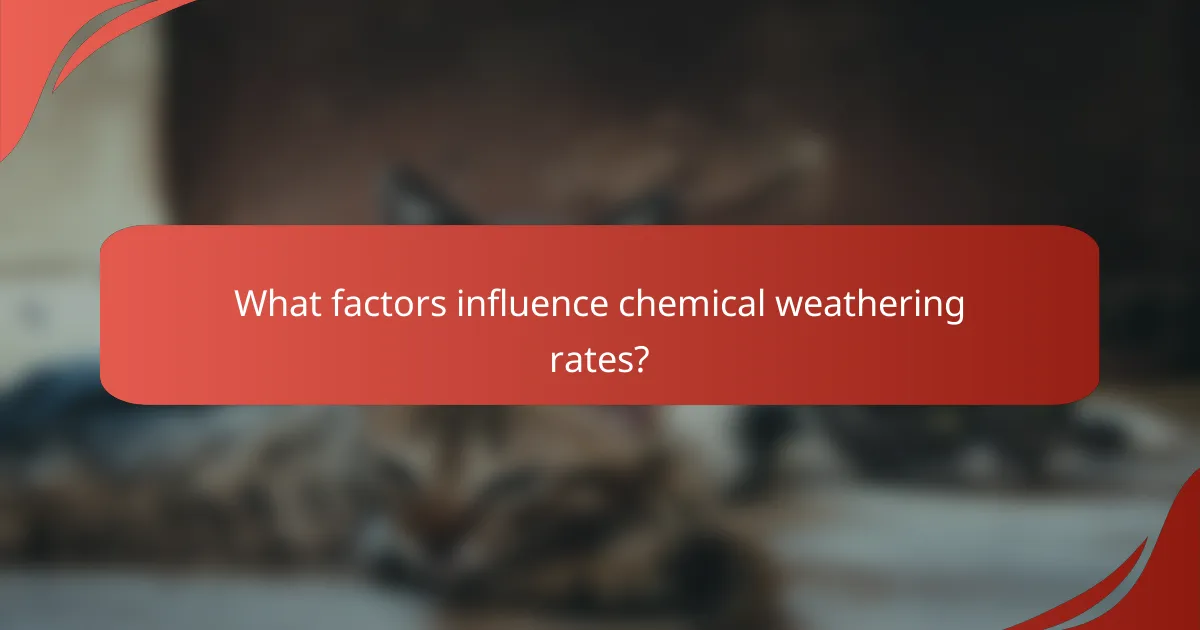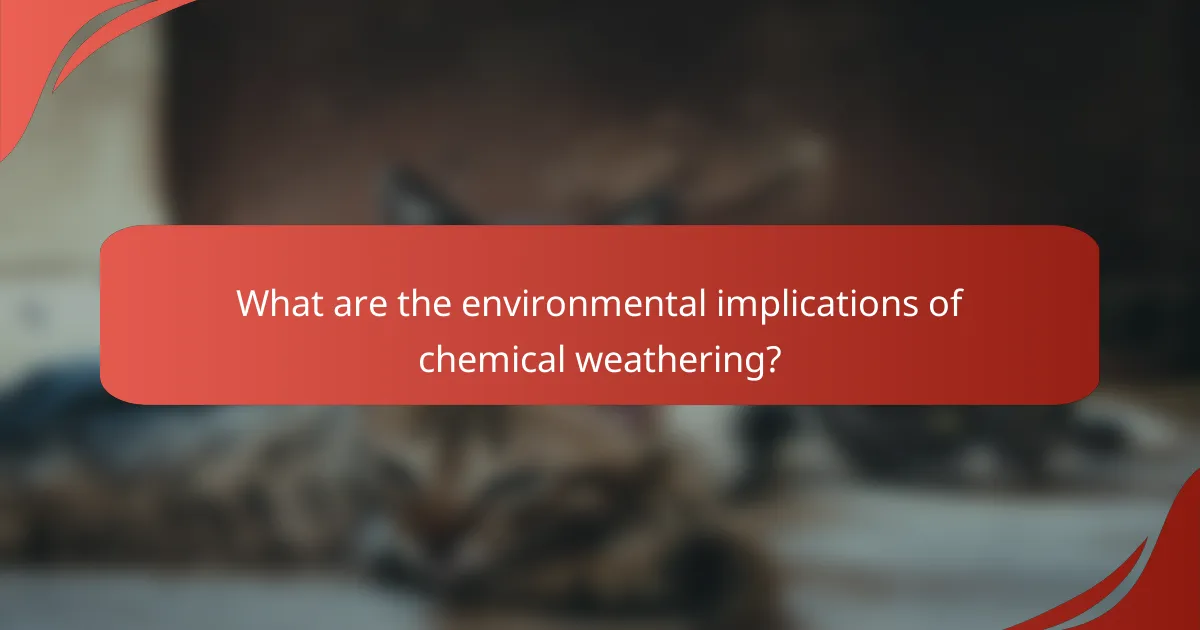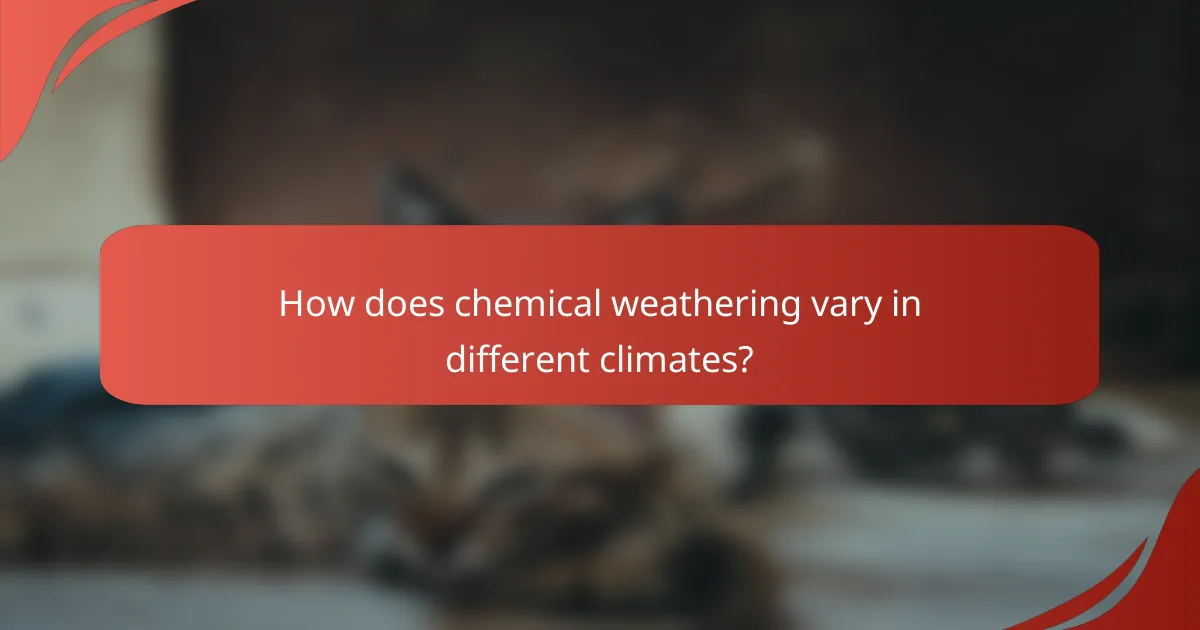Chemical weathering plays a crucial role in determining the stability and lifespan of minerals by altering their chemical structure and composition. Through processes such as hydrolysis, oxidation, and carbonation, minerals undergo significant changes that can weaken them over time. Factors like climate, mineral composition, and vegetation also influence the rate of chemical weathering, making it essential to understand these dynamics for predicting mineral durability in different environments.

How does chemical weathering affect mineral stability?
Chemical weathering significantly impacts mineral stability by altering their chemical structure and composition, leading to a reduction in strength and lifespan. This process occurs through reactions with water, acids, and other chemicals, resulting in the breakdown of minerals over time.
Reduction of mineral strength
Chemical weathering reduces the strength of minerals by breaking down their crystalline structures. For example, feldspar can transform into clay minerals, which are much weaker. As minerals lose their structural integrity, they become more susceptible to physical weathering and erosion.
This reduction in strength can vary depending on the mineral type and environmental conditions. In humid climates, where chemical reactions are more prevalent, minerals may weather more rapidly compared to arid regions.
Alteration of mineral composition
The alteration of mineral composition is a key aspect of chemical weathering. As minerals react with water and acids, they can dissolve or transform into different minerals. For instance, calcite can dissolve in acidic conditions, leading to the formation of calcium bicarbonate.
This change in composition can affect the availability of nutrients in the soil, impacting plant growth and ecosystem health. Understanding these transformations is crucial for managing soil fertility and agricultural practices.
Impact on soil formation
Chemical weathering plays a vital role in soil formation by contributing to the development of soil horizons and enhancing nutrient availability. As minerals weather, they release essential elements like potassium, magnesium, and calcium, which are vital for plant growth.
The process also leads to the formation of clay-rich soils, which can retain moisture and nutrients better than sandy soils. This is particularly important in agricultural regions where soil quality directly influences crop yields.

What are the main types of chemical weathering?
The main types of chemical weathering include hydrolysis, oxidation, and carbonation. Each process alters minerals through chemical reactions, impacting their stability and lifespan in various environments.
Hydrolysis
Hydrolysis is a chemical weathering process where water reacts with minerals, leading to the breakdown of the mineral structure. This reaction often transforms feldspar into clay minerals, significantly altering the rock’s composition.
In areas with abundant rainfall, such as tropical climates, hydrolysis is particularly effective. The presence of acidic water can accelerate this process, enhancing mineral dissolution and clay formation.
Oxidation
Oxidation involves the reaction of minerals with oxygen, often resulting in the rusting of iron-bearing minerals. This process can weaken rock structures and change their color, typically giving them a reddish hue.
Oxidation is most prevalent in dry or warm climates where oxygen is abundant. It can significantly affect the stability of minerals like biotite and olivine, leading to their gradual deterioration over time.
Carbonation
Carbonation occurs when carbon dioxide dissolves in water, forming carbonic acid, which reacts with minerals like calcite. This process is crucial in the weathering of limestone and marble, leading to the formation of karst landscapes.
In regions with high levels of CO2, such as areas with volcanic activity or dense vegetation, carbonation can be accelerated. This weathering type plays a significant role in soil formation and nutrient cycling in these environments.

What factors influence chemical weathering rates?
Chemical weathering rates are influenced by several key factors, including climate conditions, mineral composition, and vegetation cover. Understanding these elements helps in predicting how quickly minerals will break down in various environments.
Climate conditions
Climate plays a crucial role in chemical weathering, with temperature and moisture being the primary factors. Warmer temperatures generally increase the rate of chemical reactions, while higher moisture levels facilitate processes such as hydrolysis and oxidation.
For instance, tropical regions with high rainfall and temperatures experience significantly faster weathering compared to arid areas. This can lead to a more rapid breakdown of minerals, affecting soil formation and nutrient availability.
Mineral composition
The type of minerals present in a rock significantly affects its susceptibility to chemical weathering. Some minerals, like feldspar, weather more quickly than others, such as quartz, due to their chemical structure and reactivity.
For example, silicate minerals tend to weather through processes like hydrolysis, while carbonates can dissolve in acidic conditions. Understanding the mineral composition helps predict how long rocks will remain stable in a given environment.
Vegetation cover
Vegetation cover influences chemical weathering by contributing organic acids through root respiration and decay. These acids can enhance the breakdown of minerals, particularly in forested areas where plant roots penetrate the soil.
Additionally, vegetation helps retain moisture in the soil, further promoting weathering processes. Areas with dense plant life typically exhibit higher rates of chemical weathering compared to barren landscapes, impacting soil fertility and ecosystem health.

How does chemical weathering impact the lifespan of minerals?
Chemical weathering significantly reduces the lifespan of minerals by altering their chemical structure and making them more prone to degradation. This process can lead to increased instability and a higher likelihood of erosion over time.
Increased susceptibility to erosion
Chemical weathering weakens minerals, making them more vulnerable to physical erosion. For example, feldspar can transform into clay minerals through hydrolysis, which are less resistant to weathering forces. As minerals break down, they can be more easily removed by wind or water, accelerating landscape changes.
In regions with high rainfall or fluctuating temperatures, the rate of erosion can increase significantly. This is particularly evident in tropical climates, where chemical weathering processes are more active, leading to rapid mineral degradation.
Changes in mineral durability
The durability of minerals is directly affected by chemical weathering, which alters their composition. For instance, calcite dissolves in acidic conditions, reducing its presence in soil and rock formations. As minerals lose their structural integrity, their ability to withstand environmental stress diminishes.
Minerals that are initially stable may become less durable over time due to ongoing chemical reactions. This can lead to a shift in the mineral composition of soils and rocks, impacting their overall stability and longevity.
Effects on mineral resource availability
Chemical weathering can affect the availability of mineral resources by altering the concentration and accessibility of valuable minerals. For example, the leaching of metals from ores can lead to reduced concentrations in mining areas, making extraction less economically viable.
As minerals weather and deplete, regions that rely on specific mineral resources may face challenges in sustaining their supply. This is particularly relevant in areas with extensive mining operations, where ongoing chemical weathering can impact long-term resource management strategies.

What are the environmental implications of chemical weathering?
Chemical weathering significantly influences environmental conditions by altering mineral stability and affecting soil and water quality. This process breaks down rocks and minerals, releasing essential nutrients into the ecosystem while also impacting the carbon cycle and water systems.
Soil nutrient availability
Chemical weathering enhances soil nutrient availability by breaking down minerals and releasing essential elements like potassium, calcium, and magnesium. These nutrients are vital for plant growth and overall soil health. In regions with high weathering rates, soils can become rich in nutrients, promoting lush vegetation.
However, excessive weathering can lead to nutrient leaching, particularly in areas with heavy rainfall. This can deplete soil fertility over time, necessitating the use of fertilizers to maintain agricultural productivity.
Water quality impacts
Chemical weathering affects water quality by releasing dissolved minerals into nearby water bodies. This process can lead to increased mineral concentrations, which may enhance water hardness and alter pH levels. For example, calcium and magnesium from weathered rocks can contribute to higher hardness in freshwater systems.
While some mineral release can benefit aquatic ecosystems, excessive weathering can lead to problems like algal blooms, particularly if nutrient runoff occurs. Monitoring water quality is essential to manage these impacts effectively.
Carbon cycle interactions
Chemical weathering plays a crucial role in the carbon cycle by facilitating the long-term storage of carbon dioxide. As rocks weather, carbonic acid forms, which helps in the breakdown of silicate minerals, ultimately sequestering carbon in sedimentary rocks. This process is vital for regulating atmospheric CO2 levels over geological timescales.
Increased weathering rates can enhance carbon sequestration, but this is often balanced by other factors such as land use changes and climate conditions. Understanding these interactions is key for predicting future climate scenarios and managing carbon emissions effectively.

How does chemical weathering vary in different climates?
Chemical weathering varies significantly across climates due to differences in temperature, moisture, and vegetation. In tropical regions, high temperatures and abundant rainfall accelerate chemical reactions, while arid regions experience slower weathering due to limited moisture. Temperate regions present a middle ground, with moderate conditions that influence the rate and type of weathering processes.
Tropical regions
Tropical regions are characterized by warm temperatures and high humidity, creating ideal conditions for chemical weathering. The abundant rainfall facilitates processes like hydrolysis and oxidation, which break down minerals rapidly. For example, feldspar can weather into clay minerals in just a few years under these conditions.
The presence of lush vegetation also contributes to chemical weathering, as organic acids from decaying plant material enhance mineral breakdown. This results in a rich soil profile, but it can also lead to significant mineral depletion over time.
Arid regions
In arid regions, chemical weathering occurs at a much slower rate due to limited moisture and lower temperatures. The lack of water restricts the chemical reactions necessary for weathering, meaning that minerals can remain stable for extended periods. For instance, granite may take thousands of years to show significant weathering effects.
However, when rain does occur, it can lead to rapid weathering events. The infrequent but intense rainfall can cause sudden changes in mineral stability, particularly in areas with soluble minerals like gypsum or salt.
Temperate regions
Temperate regions experience moderate temperatures and rainfall, leading to a balanced rate of chemical weathering. The seasonal variations in moisture and temperature can enhance weathering processes, allowing minerals to break down at a steady pace. For example, quartz may weather slowly, while calcite can dissolve more readily during wetter months.
These regions often have diverse vegetation, which contributes organic acids to the soil, further promoting weathering. The combination of moderate conditions and biological activity results in a dynamic environment where mineral stability can fluctuate throughout the year.
